Understanding Respiratory Syncytial Virus (RSV)
What Is RSV?
Respiratory Syncytial Virus (RSV) is a virus that usually causes mild, cold-like symptoms and infects the respiratory tract in the throat, nose and lungs.1 Most infected people recover in a week or two, but RSV can be serious, especially for infants and older adults. RSV is the most common cause of bronchiolitis and pneumonia in children younger than 1 year of age in the U.S. Almost all children will have had an RSV infection by the age of 2 years.2 RSV is also a significant cause of respiratory illness in older adults.1
RSV Symptoms
RSV normally causes symptoms that are typical of other respiratory viruses, including the common cold, influenza and COVID-19.3 These mild respiratory symptoms can include:
- Runny nose or congestion
- Coughing, sneezing, wheezing
- Fever
- Difficulty breathing
- Fatigue
- Loss of appetite
Severe infections, which are more common in infants and older adults, can cause bronchitis and pneumonia.3 Severe symptoms that require medical attention can include:
- Shortness of breath
- Wheezing while breathing or rapid breathing
- Blue or gray tinted lips, nails or skin
- High fever
Incubation Period and Duration of Illness
After exposure, the typical incubation period before symptoms appear is 4 to 6 days. Once symptom onset occurs, most RSV infections resolve on their own in 1 to 2 weeks. Most people remain infectious for 3 to 8 days after symptom onset, but infants and the immunocompromised can spread RSV for up to four weeks after symptom onset.
Who Is At Risk?
Prior to the RSV vaccine, most people would be infected with RSV by the age of two. Children under the age of two, premature babies, older adults (aged 65 and older), immunocompromised people, and those with preexisting chronic health conditions such as chronic heart disease or lung disease are most at risk of severe complications.4
The Burden of RSV
From October 1, 2024 to May 3, 2025, the CDC estimated that there were between 3.6 to 6.5 million outpatient visits for RSV.6 Additionally, there were between 190,000 to 350,000 RSV hospitalizations and 10,000 to 23,000 RSV deaths in this 6-month time frame. RSV is considered the greatest cause of infant hospitalization in high-income countries.7 The economic burden of this disease is also significant. Among older U.S. adults aged 60 or older, the estimated 4 million annual cases of RSV cost $6.6 billion in 2021. This accounted for $2.9 billion of direct medical costs and $3.7 billion in indirect costs, such as lost work time.8
How RSV Spreads
Direct Contact
RSV is primarily spread directly from person to person through exposure to respiratory droplets or direct contact with an infected person. When a person infected with RSV coughs or sneezes nearby, virus-containing droplets may be breathed in or enter another individual's eyes, nose or mouth.
Surfaces and Indirect Contact
Surfaces can become contaminated if someone infected with RSV touches them or if respiratory droplets settle on them. The virus can survive for up to 7 hours on hard surfaces like tabletops and less time on soft surfaces like fabrics.9 Touching the face, eyes, nose or mouth after contact with a contaminated surface can result in transmission of the virus and subsequent RSV infection.
Preventing the Spread of RSV
Hand Hygiene
Good hygiene practices can reduce the spread of RSV. Encourage handwashing at regular intervals and especially before eating, after using the restroom, after interacting with a sick person, and after coughing or sneezing.
Cleaning and Disinfecting Surfaces
Use products with claims against RSV and disinfect all high-touch surfaces including doorknobs, countertops, and light switches. Use according to label instructions and allow the surface to remain wet for the stated contact time for RSV. The contact time, or wet time, is the time that the surface must remain visibly wet for the disinfectant to be effective against RSV. In healthcare settings it is also important to clean and disinfect shared portable medical equipment between each use.
CloroxPro Products Effective Against RSV
Many CloroxPro disinfectants can be used to kill RSV on environmental surfaces and equipment. Use these in your daily cleaning and disinfection to prevent the transmission of RSV in your facility. Always follow the label’s directions for use when cleaning and disinfecting.
| Products for use against Respiratory Syncytial Virus (RSV) | Product image | EPA Reg. No. | RSV contact time |
|---|---|---|---|
| Clorox EcoClean Disinfecting Cleaner and Refill Item No. 60213, 32 fl. oz. Spray, 9/case Item No. 60094, 128 fl. oz. refill, 4/case | 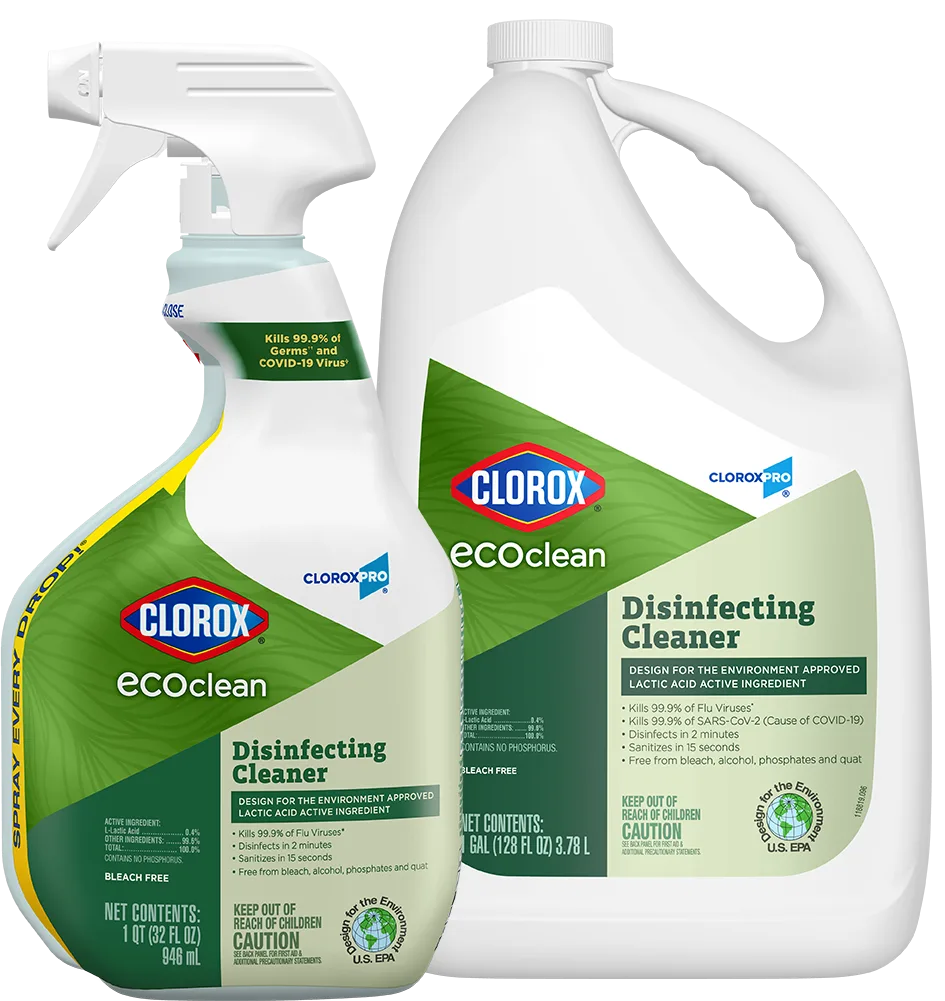 | 67619-45 | 30 sec |
| Clorox EcoClean Disinfecting Wipes Item No. 60605, 7" x 8" 75 ct. Canister, 6/case |  | 67619-48 | 5 min |
| Clorox Germicidal Bleach Item No. 30966, 121 fl. oz. Bottle, 3/case |  | 67619-32 | 5 min |
| Clorox Clean-Up Disinfectant Cleaner with Bleach Item No. 35417, 32 fl. oz. Spray, 9/case Item No. 35420, 128 fl. oz. Refill, 4/case |  | 67619-17 | 30 sec |
| Clorox Disinfecting Wipes Item No. 15949, 75 ct. Canister, 6/case, Fresh Scent Item No. 15948, 75 ct. Canister, 6/case, Lemon Scent Item No. 31547, 700 ct. Bucket, 1/case, Fresh Scent Item No. 31428, 700 ct. Bucket Refill, 2/case, Fresh Scent | 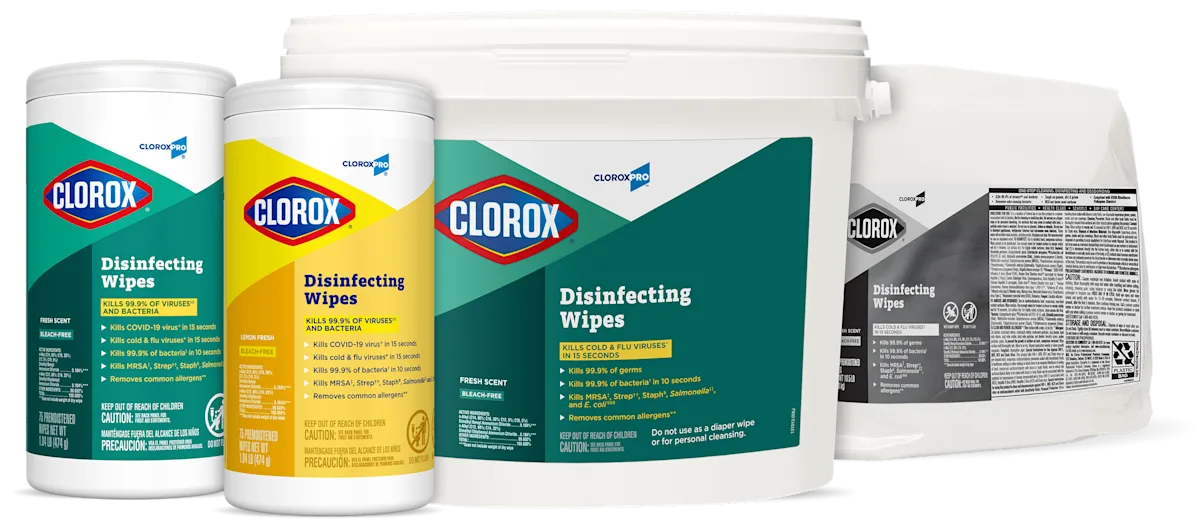 | 67619-12 | 15 sec |
| Clorox Disinfecting Spray Item No. 38504, 19 fl. oz. Aerosol Spray, 12/case |  | 67619-21 | 30 sec |
| Clorox Healthcare Bleach Germicidal Wipes Item No. 30577, 6" x 5" 150 ct. Canister, 6/case Item No. 35309, 6.75" x 9" 70 ct. Canister, 6/case Item No. 32621, 6.75" x 9" 100 ct. Softpack, 9/case Item No. 31424, 12" x 12" 50 ct. Carton, 6/case Item No. 30358, 12" x 12" 110 ct. Bucket, 2/case Item No. 30359, 12" x 12" 110 ct. Bucket Refill, 2/case | 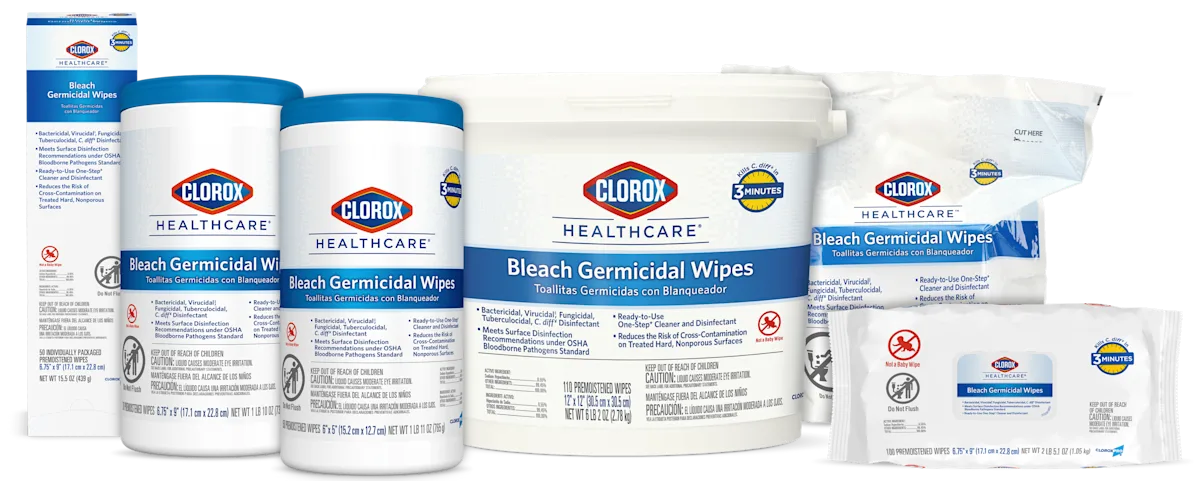 | 67619-12 | 1 min |
| Clorox Healthcare VersaSure Cleaner Disinfectant Wipes Item No. 31757, 6.75" x 8" 85 ct. Canister, 6/case, Item No. 31758, 6" x 5" 150 ct. Canister, 6/case Item No. 31759, 12" x 12" 110 ct. Bucket, 2/case Item No. 31761, 12" x 12" 110 ct. Bucket Refill, 2/case |  | 56392-7 | 30 sec |
| Clorox Healthcare Hydrogen Peroxide Cleaner Disinfectant Cleaner Item No. 30828, 32 fl. oz. Spray, 9/case Item No. 30829, 128 fl. oz. Refill, 4/case | 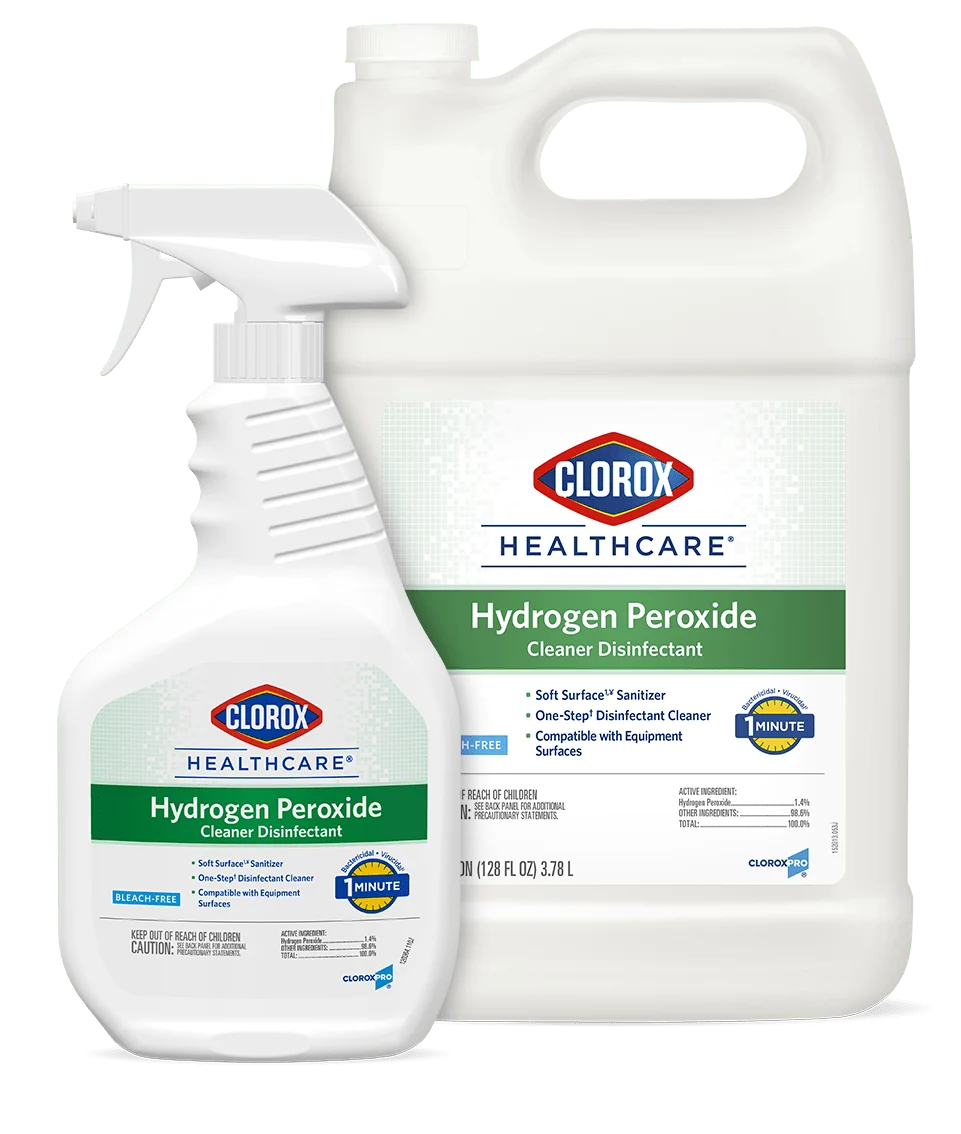 | 67619-24 | 30 sec |
| Clorox Healthcare Hydrogen Peroxide Cleaner Disinfectant Wipes Item No. 30824, 6.75" x 9" 95 ct. Canister, 6/case Item No. 30825, 6.75" x 5.75" 155 ct. Canister, 6/case Item No. 30826, 12" x 11" 185 ct. Bucket, 2/case Item No. 30827, 12" x 11" 185 ct. Bucket Refill, 2/case | 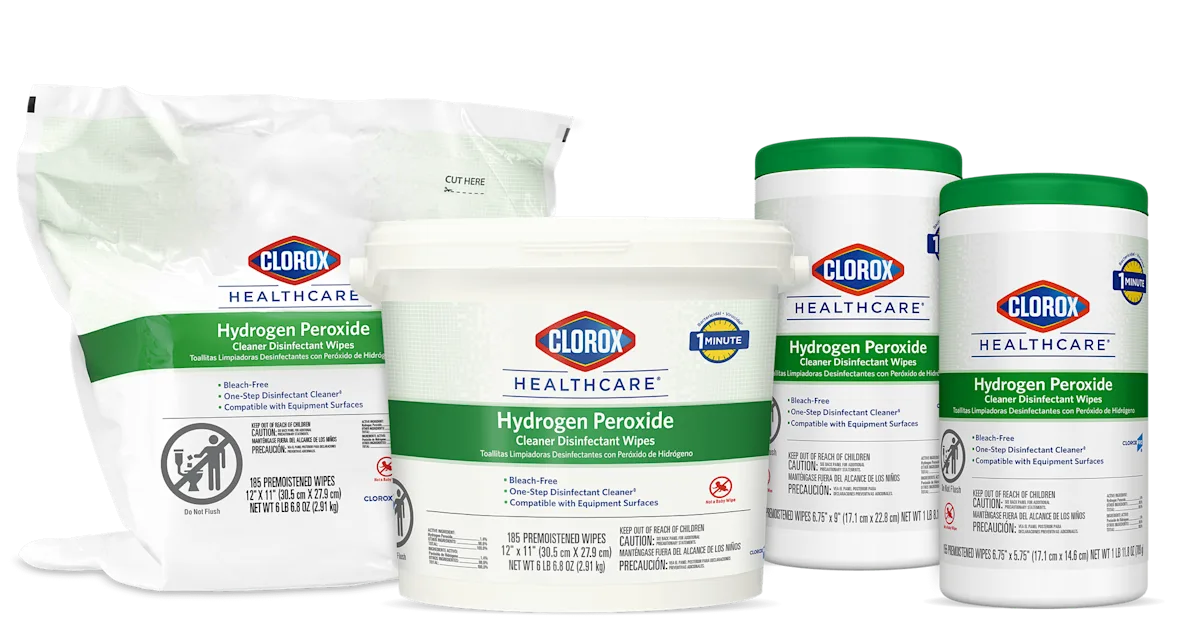 | 67619-25 | 30 sec |
| Clorox Healthcare Fuzion Cleaner Disinfectant Item No. 31478, 32 fl. oz. Spray, 9/case |  | 67619-30 | 1 min |
| Clorox Healthcare Spore10 Defense Cleaner Disinfectant Item No. 32122 128 fl. oz. for Sprayer Devices, 4/case Item No. 32409, 128 fl. oz., 4/case |  | 67619-40 | 1 min |
Other Resources
References
- Respiratory syncytial virus. (2024). Centers for Disease Control and Prevention. https://www.cdc.gov/rsv/index.html (Accessed August 12, 2025).
- Surveillance of RSV. (2025, July 6). CDC. https://www.cdc.gov/rsv/php/surveillance/index.html (Accessed August 12, 2025).
- Cleveland Clinic. (2025, May 7). What Is RSV & What Are the Symptoms? https://my.clevelandclinic.org/health/diseases/rsv-respiratory-syncytial-virus (Accessed August 12, 2025).
- Mayo Clinic. (2023, October 4). Respiratory syncytial virus - Symptoms and causes. https://www.mayoclinic.org/diseases-conditions/respiratory-syncytial-virus/symptoms-causes/syc-20353098 (Accessed August 12, 2025).
- Respiratory Syncytial Virus (RSV) Tests: MedlinePlus Lab Test Information. (n.d.). Medlineplus.gov. https://medlineplus.gov/lab-tests/respiratory-syncytial-virus-rsv-tests/ (Accessed 12, 2025).
- CDC. (2025, July 8). Preliminary Estimates of RSV Burden for 2024-2025. CDC.gov. https://www.cdc.gov/rsv/php/surveillance/burden-estimates.html (Accessed August 12, 2025).
- Munro, A., Martinón‐Torres, F., Drysdale, S. B., & Faust, S. N. (2023). The disease burden of respiratory syncytial virus in Infants. Current Opinion in Infectious Diseases, 36(5), 379–384. https://doi.org/10.1097/qco.0000000000000952
- Carrico, J., Hicks, K. A., Wilson, E., Panozzo, C. A., & Ghaswalla, P. (2023). The Annual Economic Burden of Respiratory Syncytial Virus in Adults in the United States. The Journal of Infectious Diseases, jiad559. https://doi.org/10.1093/infdis/jiad559
- Dias, M. (n.d.). RSV (Respiratory Syncytial Virus). Yale Medicine. https://www.yalemedicine.org/conditions/rsv-respiratory-syncytial-virus (Accessed August 12, 2025).
- CDC. (2025, July 8). Vaccines for Adults. Respiratory Syncytial Virus Infection (RSV). https://www.cdc.gov/rsv/vaccines/adults.html?CDC_AA_refVal=https%3A%2F%2Fwww.cdc.gov%2Frsv%2Fvaccines%2Folder-adults.html (Accessed August 12, 2025).













